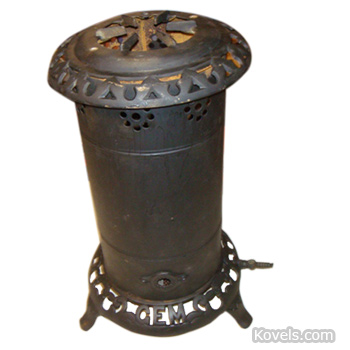Q: Recently I came across this antique stove, but I can't figure out how it works. The word "GEM" is in the middle of the base, but there are no other markings, serial numbers, or a city where it was made – nothing. I've gone to a half-dozen antiques stores and searched the web but I can't find a good match. The stove is 18 inches high and has three feet. The top is 10 inches across with a 5-inch opening where the grates are. There is a brass valve sticking out on the bottom that indicates it takes propane. I don’t know how old it is and I'd love to know its value. But even more, I would like to learn about its history. What company made it and when? Was it mainly upper-class people who owned them or did everyone have one in their house? Is it safe to use?
A: Parlor stoves were used in many homes in the early to mid-1800s, before central heating became available. Well-to-do families had fancier stoves with ornate decoration. The Gem City Stove Manufacturing Co. was one of several stove manufacturers located in Quincy, Illinois, in the late 19th and early 20th centuries. Quincy is known as "Gem City." Gem City Stove was in business by 1895 and was still operating in 1926. Early stoves were fueled by wood or coal; gas stoves didn't become common until the 20th century. Propane was first produced commercially about 1910 and was a popular home heating fuel by the 1920s. Your stove seems awfully small to be a real stove. Most parlor stoves are close to 3 feet or more. Maybe it was meant for a bedroom. If you plan to use it, you should have the stove checked by an expert who is familiar with propane stoves. There is a stove collectors club, the Antique Stove Association. Their website is www.antiquestoveassociation.org.




I have a New Process no. 252M and I can’t find ANY info on it. Can you help?
I have one that is 8″ wide by 14″ tall and has a plate on the front with GAIL 100 on it. I made this into a table lamp about 35 years ago… quite charming! Always thought it was a salesman’s sample…
Due to the small size, could this be a salesman’s sample?
Over the past 45 to 50 year’s I’ve seen a lot of different salesman’s samples, including a miniature clothes washer which was detailed exactly like the real full size ones, and many cast iron cook stoves, some with chrome
accents, and all of the ones I’ve seen were usually under 2 feet. Salesman’s samples run pretty high pricewise. The washer was offered on Pickers on the history channel at $1400 and Mike Clum auctions had a large collection of the cook stove. I don’t know what they brought, as we didn’t get to that auction, but I saw them before the auction and they were gorgeous!
Because of its size, I wonder if this propane stove might have been used in a taxi? My father was born in 1918, in a very cold December when the Spanish flu epidemic forced new mothers and their babies to be sent home early from the hospital. The family story is that there was a little stove in the taxi to keep passengers warm.
These small sheet steel stoves are kerosene heaters from the early 20th century (and therefore, rather dangerous); Google kerosene for similar models. https://www.youtube.com/watch?v=CCMPmTlpTho for a Gem kerosene heater in action. I’m thinking they were cheap goods; I often see rusty remains of them in old dumps and such. Sometimes they were actually colored enamel over steel.
This might very well be a salesmanship version of there stove they were selling its a possibility it seems awful small for any heating application back then